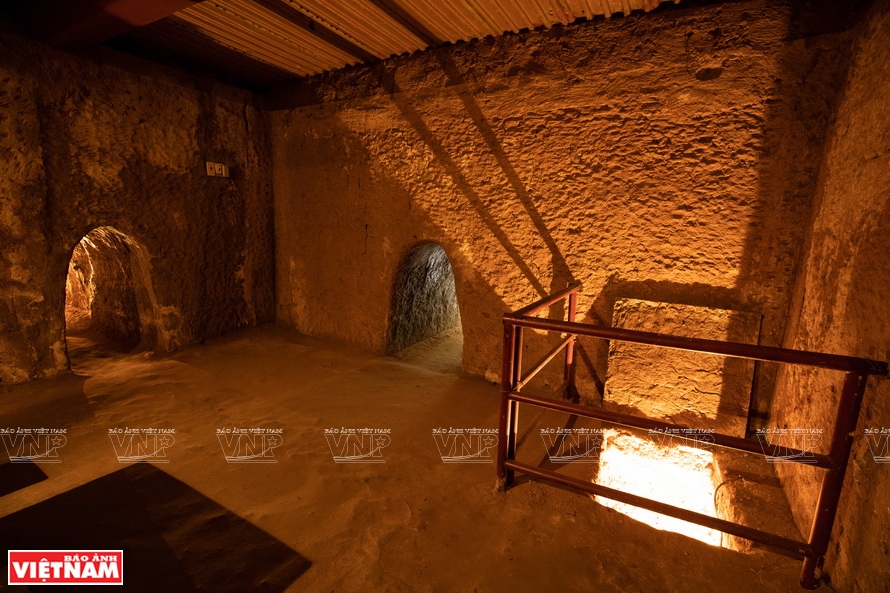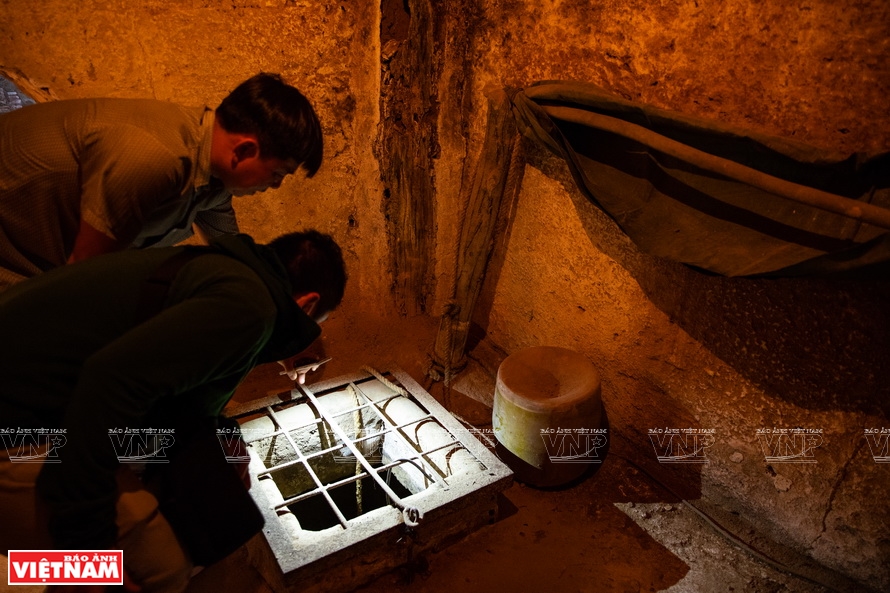The Cu Chi Tunnels are an underground network located in Tan Phu Trung and Phuoc Vinh An communes, Cu Chi district. They were originally simply structured short paths used to hide resistance forces, documents and weapons, and support communication, each of which was built separately by a village in these communes. To meet the need for communication between villages, these paths were later linked, forming a complex interconnected network. By 1965, some 200 km of tunnels and 500 km of surrounding combat trenches were dug, which were turned into a system of crisscrossing tunnels with three floors. The top floor is about 3m deep; the middle floor, 6m deep; and the bottom floor, 8-12m deep with numerous trenches. Inside the tunnels are functional areas such as dining rooms, meeting rooms, first-aid rooms, film screening rooms, and kitchens where Hoang Cam stoves (a stove which can diffuse and dissipate smoke from cooking) were used. The network has exits open to the Saigon river and a secretly-covered ventilation system.
|
By 1965, some 200km of tunnels and 500km of surrounding combat trenches were dug, which were turned into a system of crisscrossing tunnels with three floors. The top floor is about 3m deep; the middle floor, 6m deep; and the bottom floor, 8-12m deep with numerous trenches. |
The tunnels were built in a lateritic soil-clay area and were thus strong and long-lasting and could withstand the power of heavy weapons. Stairs between floors have lids that go to secret vaults. The shelter’s entrance was camouflaged with leaves. The paths inside the tunnels are different sizes but are normally wide and high enough for only one person walking bent over.
|
Military and locals in Nhuan Duc commune, Cu Chi dug tunnels between 1946 and 1968. Photo: Files of Cu Chi war memorial park
People of Trung Lap Ha commune, Cu Chi, dug trenches (1966). Photo: Files of Cu Chi war memorial park.

Large meeting room in Cu Chi Tunnels. Photo: Le Minh / VNP
 The roads inside Cu Chi Tunnels. Photo: Le Minh / VNP  Model of the operating room inside the tunnel. Photo: Le Minh / VNP  Visitors in Hoang Cam kitchen area inside Cu Chi Tunnels. Photo: Le Minh / VNP  Working tools of military men inside Cu Chi Tunnels. Photo: Thong Hai / VNP  Pillars and tunnels inside the Tunnel. Photo: Files of Cu Chi war memorial park  A well in the tunnel. Photo: Le Minh / VNP
Tourists inside Cu Chi Tunnels. Photo: Files of Cu Chi war memorial park
Tourists getting out of the tunnel. Photo: Thong Hai / VNP
Model of the resting and working space of the military. Photo: Files of Cu Chi war memorial park |
The tunnels were formed thanks to the efforts of thousands of soldiers and locals in Cu Chi, who, despite regular attacks by the enemy, carried huge loads of clay and dug channels with simple tools such as hoes and shovels. Many sections of the network were dug over and over again due to the destruction by the bombs and tanks of the enemy, reflecting the resilience and creativity of the Cu Chi people during the resistance war.
| At the tunnels, visitors are astonished at a systematic network, which was built by hand. They can also visit the Cu Chi liberated area which simulates Cu Chi during the period of 1960-1975. The area is like a miniature southern village which nestles near a green bamboo forest with the daily life activities of the locals. |
The tunnels played an important role in major battles, including the Tet Offensive of 1968 and the Great Spring Victory of 1975.
Visiting the tunnels in 1975, Cuban Minister of Culture Armando Hart Davalos wrote “Only men of bravery and honor could understand Cu Chi. The imagination and culture of Vietnam transformed it into a sacred place and into one of the greatest legends of the century.” This is only one of thousands of expressions of admiration by foreign friends visiting the site.
Given its original architecture and historical value, the People’s Committee of Ho Chi Minh City is compiling a dossier for UNESCO’s recognition of a world heritage for the Cu Chi Tunnels.
A special historical relic
After 1975, the tunnels were preserved, becoming a revolutionary historical relic where visitors can explore its original architecture and imagine the tough fight and lives of locals and soldiers during the war.
At the tunnels, visitors are astonished at a systematic network, which was built by hand. They can also visit the Cu Chi liberated area which simulates Cu Chi during the period of 1960-1975. The area is like a miniature southern village which nestles near a green bamboo forest with the daily life activities of the locals. There are also other places of interest such as a temple dedicated to Ben Duoc fallen heroes, a weapon display section, and an East Sea simulated lake. The site also showcases three models representing the country’s northern, central and southern regions, which are One Pillar Pagoda in Hanoi, Noon Gate in Hue, and Nha Rong Wharf in Ho Chi Minh City.
Visitors to the tunnels can experience transplanting rice and catching fish or do activities such as shooting and biking. They will also have chances to taste local specialties, including boiled cassava, a traditional dish in Cu Chi during the war.
|
The delegation of the Russian Ministry of Foreign Affairs visits Cu Chi Tunnels (February 24, 2019). Photo: Files of Cu Chi war memorial park
 Trench in the liberated village of Cu Chi War Memorial Park. Photo: Le Minh / VNP Trench in the liberated village of Cu Chi War Memorial Park. Photo: Le Minh / VNP
 Bomb and ammunition recycling factory in Cu Chi War Memorial Park. Photo: Le Minh / VNP
Model of a Vietnamaese soldier defusing bombs in Cu Chi War Memorial Park. Photo: Thong Hai / VNP
 Tourists are introduced to Vietnamese war traps in Cu Chi War Memorial Park. Photo: Le Minh / VNP  Recreated daily life and space in the liberated village of Cu Chi War Memorial Park. Photo: Le Minh / VNP Bombs and ammunition displayed at Cu Chi Tunnels. Photo: Le Minh / VNP  Tourists visit the tank display area. Photo: Le Minh / VNP 
A C130 in the exhibition area. Photo: Le Minh / VNP

Tourists visit the liberated village. Photo: Files of Cu Chi war memorial park

Ben Duoc martyrs memorial temple. Photo: Files of Cu Chi war memorial park
|
| According to the Cu Chi Tunnels management unit, the site annually hosts around 1.5 million foreign and domestic visitors, including state-level officials from different countries. |
According to the Cu Chi Tunnels management unit, the site annually hosts around 1.5 million foreign and domestic visitors, including state-level officials from different countries.
As years have gone by, warfare traces may have faded. Yet the Cu Chi Tunnels have stayed almost intact, remaining a special historical site which deserves UNESCO’s world heritage recognition
Photos: Le Minh, Thong Hai & Files ofCu Chi war memorial park
Translated by Hong Hanh




